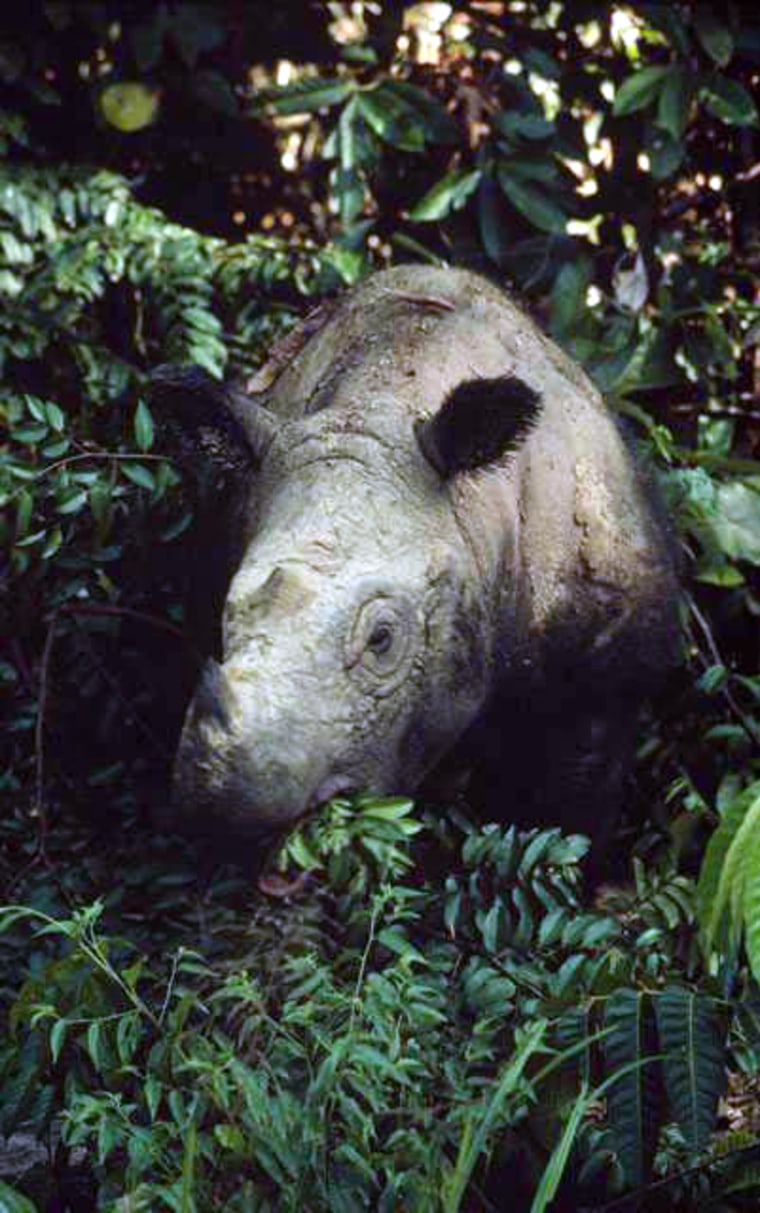A Malaysian expedition found evidence of at least 13 Sumatran rhinos deep in the jungles of Borneo, giving hope to conservationists that a species thought to be nearly extinct could flourish again if poaching is controlled.
The rhinos were tracked into the dense jungles of Sabah state in Borneo Island in May by a team of 120 government wildlife officials, academics and members of WWF-Malaysia, the WWF said in a statement Friday.
The survey team did not see any rhinos but found clear tracks of 13 individuals in one area — a high number, considering they were believed to be virtually extinct, Christy Williams, the head of WWF's Asian rhino program, told The Associated Press.
"This is the first time we have found so many rhinos in a compact location ... it's a great discovery," Williams said in a telephone interview from Katmandu, Nepal.
WWF is the worldwide conservation group also known as World Wildlife Fund.
The survey team trekked in heavy tropical rains in leech-infested jungles during the two-week expedition, Williams said. Their discovery — in an area known as the "Heart of Borneo" — was not made public until now to allow officials time to erect "strong protection measures" against poachers, the WWF statement said.
Rhino protection units of WWF-Malaysia and Sabah state have now launched patrols in the area, it said.
"Poaching has decimated Borneo's once-healthy rhino population, but we were heartened to find that a few individuals have managed to cling to survival," said Raymond Alfred of WWF-Malaysia.
Borneo Island is divided between Malaysia's Sabah and Sarawak states and Indonesia's Kalimantan province. The sultanate of Brunei also takes up a sliver of land on the western coast.
Rhino horn used in medicines
Sabah is the last preserve of the Borneo Sumatran Rhino, a subspecies of the Sumatran Rhino. It has already become extinct in Kalimantan and Sarawak, hunted by poachers for its horn, which is virtually worth its weight in gold in the black-market for use in traditional Asian medicines.
Less than 300 rhinos of the second subspecies, the Western Sumatran Rhino, are believed to be living in Sumatra, Indonesia and mainland Malaysia.
WWF officials said that surveys in 1992 and 1995 in Sabah had found fewer than 13 rhinos, scattered over a vast area.
Rhinos are solitary animals, but the 2005 survey results seem to indicate that the 13 rhinos are in an area untouched by poaching. This means the animals have a reasonable chance to meet each other and breed, Williams said.
"There is also evidence that there are young animals in the group so it would appear that breeding is indeed taking place," said Williams. He said this has sparked hopes that the population of Borneo Sumatran Rhino can again flourish, at least in Sabah.
‘Last hope’ in Sabah
"Sabah holds the last hope for this rhino. We had all thought rhinos were in much worse shape," he said.
Sabah's Chief Minister Musa Aman said this week that logging will be phased out in large tracts of forests in the "Heart of Borneo" area, which includes the rhino habitat.
Other threatened wildlife in Borneo includes clouded leopards, sun bears, and three species of leaf monkeys found nowhere else in the world.
